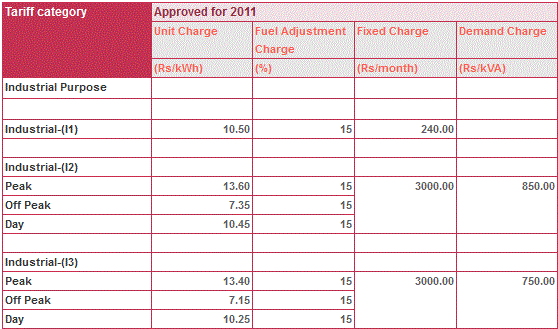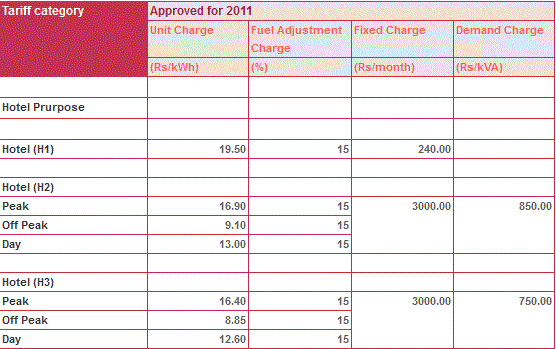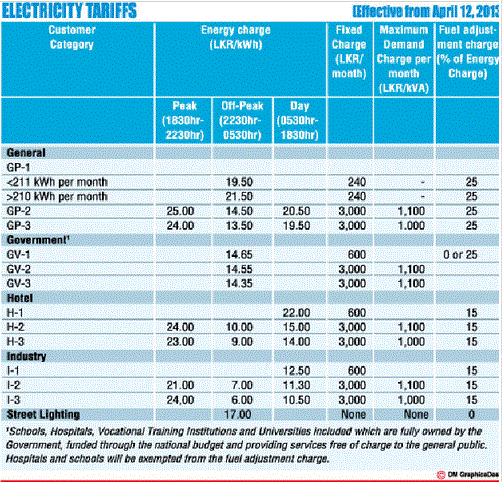It is frequently assumed that the subject of economics is chiefly concerned with the movement of money. This is incorrect. The main preoccupation in economics is how people make choices. The key to understanding and guiding an economy is this distillation and aggregation of individual choices.
Here is something flabbergasting that arises from applying an economic understanding of how choices are made to the proposed new electricity tariffs in Sri Lanka in April 2013. The new electricity tariffs will make people feel poorer and also encourage them to consume more electricity. It is also partly self-defeating. The explanation is rather simple.
Two impacts on consumption: Income and priceTwo things matter in the choices that a person makes to consume. The total income power of that person (called the ‘income effect’) and the relative price of what they aim to consume (called the ‘substitution effect’). This is quite intuitive: In simple terms, it means, you tend to consume more when you feel richer and you tend to consume more of something when it becomes cheaper.
Two kinds of prices: Average and marginal The concept of cheaper can be thought of in two ways. Only one of them really matters. One way to think about cheaper is to think about the ‘average cost’ of the consumption. The other way is to think of the ‘marginal cost’.
What is meant by ‘marginal cost’ is simply the cost of the last extra unit of consumption. It is the ‘marginal cost’ that mostly matters and in the absence of proper substitutes for essential items, the marginal cost may be the only thing that matters.
Quantity is determined by the marginalLet’s take an example. Petrol is priced higher than diesel in Sri Lanka. As a result, owners of petrol vehicles pay more for every kilometer of running than owners of diesel vehicles. To compensate for this indirect subsidy, family-owned diesel vehicles are subject to a hefty annual tax.
As a result, when the total tax plus fuel price is added up, it could very well be the case that ‘on average’ the diesel vehicle owner pays more per kilometer. But when it comes to deciding on whether it would be a good idea to nip down to Galle and back on a poya holiday, it is also the diesel vehicle owner that is more likely to choose it. That is because the cost per kilometer for that extra running is very much less than for the petrol vehicle owner and it is that ‘marginal cost’ that determines the choice of ‘how much’ to run.
Bygones are bygonesHigh fixed costs that increase the average cost of consumption are what economists call ‘sunk costs’. They don’t determine choices after that cost is paid.
High fixed costs can affect a person’s disposable income and with that their sense of being richer or poorer. This ‘income effect’ would lead to consuming less in general of everything and looking for cheaper substitutes of those things that are being consumed. In our example, the hefty tax paid by the diesel vehicle owner is a fixed sunk cost.
The resulting ‘income effect’ (making him feel poorer) could lead him to look for less expensive hotels in Galle, but it will not discourage him from travelling itself (because for the travel cost, he already has the cheaper substitute).
In fact, the ‘the buffet effect’ could kick in and cause him to travel even excessively more to psychologically justify the high tax already paid! (Don’t people often eat too much at buffets where the fixed and average cost is high, but the marginal cost of extra food is zero?)
It’s same with electricityThis logic applies to consumption of electricity as well and even more so, because what substitute does a home have for electricity? The poorest, without refrigerators, could switch to kerosene lamps (but the price of kerosene has also skyrocketed recently).
The new tariff structure proposed by the Ceylon Electricity Board (CEB) significantly ‘increases’ the average price of electricity and the increase is much greater for those that consume less. But in a befuddling twist, it changes the structure of pricing so as to ‘decrease’ the marginal price and especially for those who consume more.
Graph tells the storyThe graph looks complicated but is simple to understand. It shows the extra cost a person has to pay for a single extra unit of electricity at various levels of consumption. It shows this both under the existing tariff structure and the proposed tariff structure.
This is what the graph says: The proposed tariff imposes a much higher marginal cost than at present on the first 30 units of consumption: A 66 percent increase. And, less, but still, an increase in marginal cost up to the first 90 units (28 percent and 13 percent, see the table for the numbers).
After that, the proposed tariff structure actually ‘decreases’ the marginal cost for every category, including the highest consumers. The greatest reduction is for those consuming between 90 and 120 units (a 29 percent reduction) and those consuming between 180 and 210 units (a 33 percent reduction).
So, here is what the new electricity tariff is going to do. It is going to make people feel poorer and also induce them consume more electricity, thereby forcing reductions in everything else like food and newspapers.
Economics not accountsTypically, an accounting approach can focus on pricing that is geared to recover costs. The new tariff structure is projected by the CEB to change the total revenue from the domestic sector from what was previously a very large subsidy of 39 percent to a small profit of about 2 percent (based on costs). That is a big shift. But the approach to pricing is wrong-headed and self-defeating.
Why? First, those at the low end of consumption, where marginal costs are increased, will have the least ability to reduce consumption. Those at the high end of consumption where greater vigilance could substantially reduce consumption are being encouraged to consume more through lower marginal costs.
Second, it is also the last units of electricity that cost the CEB the most. Hydropower for instance costs less than about Rs.5 per unit to produce. Coal power costs only a little bit more. Given the average cost in excess of 20, it means that the extra units purchased from Independent Power Producers could be costing the CEB well in excess of Rs.30 (some unconfirmed estimates place it at above Rs.60).
This means that those consuming between 92 and 210 units that are now being encouraged to consume more by the new tariff structure could in fact be paying less for that extra consumption, than it costs the CEB to source that extra power to them.
There is more to be done for a comprehensive analysis. But the insight is important. The structure of the problem is better represented from an economics rather than purely accounting approach. This is why the proposal for the new electricity tariffs would have benefited by some tête-à-tête with economists. Maybe it is not too late.
(Verite Research provides strategic analysis and advice for government and the private sector in Asia)
http://www.dailymirror.lk/business/features/28214-new-electricity-tariffs-cost-wise-price-foolish.html
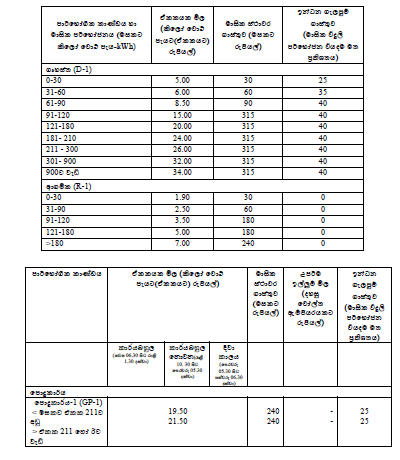
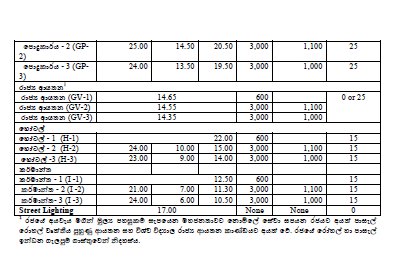
 would enable you to enjoy an array of other services such as Member Rankings, User Groups, Own Posts & Profile, Exclusive Research, Live Chat Box etc..
would enable you to enjoy an array of other services such as Member Rankings, User Groups, Own Posts & Profile, Exclusive Research, Live Chat Box etc.. 
 Home
Home












